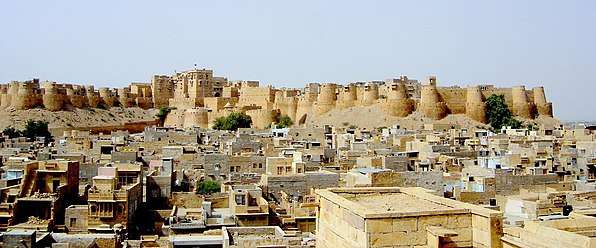Bhati
Bhati is a clan of Rajputs,[1] Gurjars,[2] and Jats[3] found in India and Pakistan.[4] The Bhati Rajputs (also known as Bargala) claim Chandravanshi origin.[5]

In Jaisalmer, the Bhati clan sometimes refer to themselves as the Yadavpati, reflecting their claimed mythological descent from Krishna and Yadu.[6]
Some Gurjar Bhatis were nomadic cattle-keepers. In the years preceding the Indian rebellion of 1857, these groups lost land by decisions made by the British East India Company, which assigned to Jat peasants grazing lands formerly frequented by the Bhatis in the Delhi and Haryana regions. The British were not enamoured of nomadic tribes, whom they thought exacted protection in the areas that they visited, and the policies of land reform were designed in part to limit this mobility.[7]
At least some of the Bhati Rajputs of Rajasthan were among the communities that practised female infanticide between 1883–1998.[1] One princess, a daughter of the Hindu Bhati ruling family in Dipalpur, was married to Salar Rajab, a Turkic Muslim ruler, and gave birth to Firuz Shah Tughlaq. This was one of several examples of inter-religious royal marriage alliances during the period of Turkic Muslim rule in the Indian subcontinent.[8] Rajput Bhati princesses were also married into the royal family of Jodhpur.[9]
The Sikh Sidhu Jatt rulers of Patiala and Nabha also claim descent from the Bhati ruler Rawal Jaisal.[10][11] Geographically, the Sidhu are from the Punjab region of India.[12]
In some parts of modern Pakistan, especially in the Northern and Central Punjab, low-caste doms (or Mirasi singers/dancers) now also call themselves 'Bhati'; a fact deeply resented by the authentic Bhati Rajputs of Pakistan.[13]
See also
References
- Bhatnagar, Rashmi Dube; Dube, Reena (2005). Female Infanticide in India: A Feminist Cultural History. SUNY Press. p. 254. ISBN 978-0-7914-6327-7.
- Singh, Kumar Suresh, ed. (1998). India's communities. Oxford University Press. ISBN 978-0-19-563354-2.
The Hindu Gujjar have a number of clans (gotra), such as Bainsale, Bhati, Bankar, Korri, Dhame, Godhane, Khari, Nangari, Khatana Pedia, Peelwar, Tanwar, Fagna, Vidhuri, Vasatte and Lomor
- Eaton, Richard M. (2017). "Reconsidering 'Conversion to Islam' in Indian History". In Peacock, A. C. S. (ed.). Islamisation: Comparative Perspectives from History. Edinburgh University Press. p. 386. ISBN 978-1474417129. Retrieved 30 January 2020.
- Zafar Iqbal Chaudhary (November 2009). "Epilogue: Bridging divides". Epilogue. 3 (11): 48.
- Singh, Kumar Suresh, ed. (1998). India's communities. Oxford University Press. p. 301. ISBN 978-0-19-563354-2.
Bargala, also known as Bhutta Rajput, the Bargala live in Uttar Pradesh. They trace their origin to Chandravanshi Rajput ruler Jagpalii Vare Singh
- Bose, Melia Belli (2015). Royal Umbrellas of Stone: Memory, Politics, and Public Identity in Rajput Funerary Art. BRILL. p. 8. ISBN 978-9-00430-056-9.
- Bayly, Christopher Alan (1990). Indian Society and the Making of the British Empire (Reprinted ed.). Cambridge University Press. pp. 143, 188–189. ISBN 978-0-521-38650-0.
- Sarkar, Jadunath (1994) [1984]. A History of Jaipur (Reprinted, revised ed.). Orient Blackswan. p. 37. ISBN 978-8-12500-333-5.
- Karve, Irawati Karmarkar (1968). Kinship Organization in India (Third ed.). Asia Publishing House. p. 168.
- Ganda Singh (1990). Sardar Jassa Singh Ahluwalia. Punjabi University. pp. 1–4.
- Punjab Through the Ages by S. R. Bakshi & Rashmi Pathak Volume 1 First edition Pg.16
- Judge. Mapping social exclusion in India: Caste, Religion, and Borderlands.
- Dr M Riyasat Husain 'Caste and clan in Northern and Central Punjab and some patterns of shift: An analysis' in Journal of South Asian Study Vol 2, No 8, 1992, Lahore, pp. 21–46